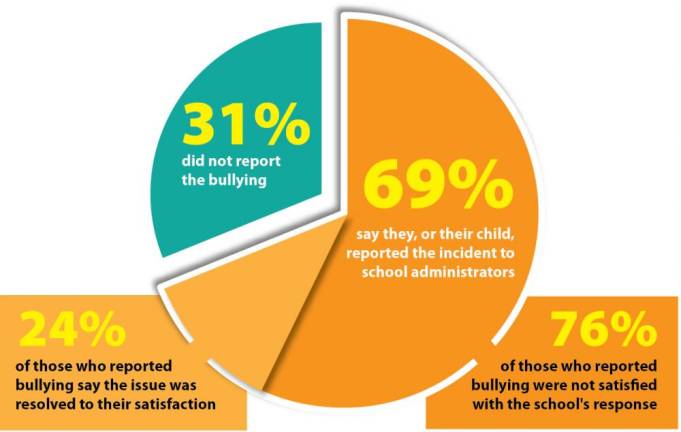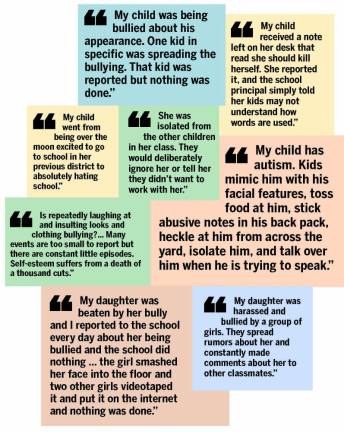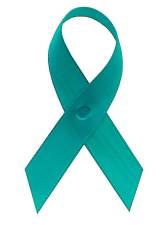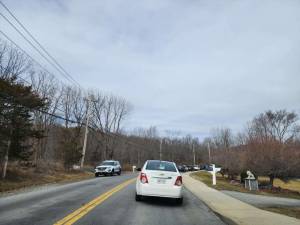Since April 2022, Paula Fetherman has filed 14 harassment, intimidation and bullying (HIB) reports at High Point Regional High School in Sussex, N.J.
The reports flagged instances in which she believes her daughters were victims of bullying. All but four reports involved her oldest, Davida, now a sophomore.
Of those 14 investigated reports, school administrators deemed two to be confirmed cases of bullying: one in which Davida, who has a disability, was called “special needs” by another teen and another in which Fetherman’s younger daughter was shown a text message with derogatory language about Davida, commenting about how both children are adopted.
The other reports were not deemed bullying by the school, Fetherman says. They include:
• Two instances in which a student took Davida’s Chromebook, in April 2022 and again May 3, 2022.
• On May 4, 2022, the same student grabbed and held onto Davida’s arm in the hallway.
• A different student, who Fetherman says is in the same friend group of the teen who took her daughter’s Chromebook, took Davida’s lunchbox Sept. 30, then took and passed around her water bottle Oct. 11., then took and hid her jacket Oct. 24.
• On Oct. 28, a different teen took Davida’s lunchbox and threw it at another student in the cafeteria, who then threw it on the floor.
• Between Nov. 11 and 18, a different student kept high-fiving Davida, calling her “babe” in a way that made her uncomfortable, and another repeatedly called her a whore.
Fetherman pulled Davida from school after she came home Friday, Nov. 18, and mentioned thoughts of suicide.
“High Point is deeply committed to ensuring that every single student feels safe, and protected, and welcome, and well every single day. And we will work with parents and staff to assure that, at all times, for all students,” said High Point Regional High School’s Director of Curriculum and Instruction, Seamus Campbell.
Rules of bullying
Local school administrators say many bullying reports - called HIB in New Jersey and DASA (Dignity for All Students Act) complaints in New York - do not end up being confirmed as bullying or harassment events after investigation.
“Especially at the high school, there are quite a number of investigations. But not necessarily do they result in saying: Yes, this is a result of bullying,” said Elsie Rodriguez, superintendent of Monroe-Woodbury Central School District. “The interesting thing about bullying is it’s really an individual case-by-case review.”
To determine whether an incident is considered bullying, officials in both the Delaware Valley School District (DVSD) and Monroe-Woodbury said they look for patterns of behavior.
“When we’re looking at what true bullying is, it’s something that’s pervasive and it’s ongoing. It’s not a one-time situation ... . It’s not something that’s done in anger passing,” said DVSD Superintendent Brian Blaum. Instead, it’s a series of behaviors meant to strike at the emotional well-being of another student, he said.
If one student pushes another in the hallway, “it might seem like bullying, but unless it’s a constant pattern of behavior, we don’t consider that bullying,” said Rodriguez.
High Point Regional High School investigated 21 reports during the 2021-22 school year, and nine were confirmed by administration to constitute bullying.
“I would say that’s fairly consistent - somewhere between one-third and one-half of investigations result in the determination of a HIB,” said Campbell. “More than half the time, it’s determined to be unfounded or a conflict.”
Just because an incident doesn’t fit a school or state’s interpretation of bullying, it doesn’t mean that the offending student isn’t reprimanded - or that the student who was being “bullied” doesn’t receive support.
“The support that we put in place for students involved in HIB are really no different than the supports we put in place for a student who has a particular need, even if there’s not a HIB involved,” said Campbell. “Likewise, the consequences for a student who is confirmed to have committed a HIB are no different than if it was any other type of Student Code of Conduct violation. And those range all the way from mediation, detention on the lesser end and suspension on the higher end.”
Regarding the incident with the teen who took Davida’s Chromebook and grabbed her by the arm, for example, a “no contact order” was put in place: Neither student was allowed to speak to the other in person or online.
However, Fetherman said she was the one who requested the added measures.
She also said High Point officials offered Davida an aide to follow her around the school as a layer of protection from other students. That, for a student with disabilities who used to have an aide in her elementary years, felt like a punishment.
Prove it
The legal definition of bullying varies from state to state. In New Jersey, the harassment must be motivated by a student’s actual or perceived characteristic, such as race, gender or a disability. New York and Pennsylvania laws do not have that stipulation.
Some of the laws’ verbiage can be vague. In New Jersey, for an act to be considered bullying, intimidation or harassment, it also must cause “substantial disruption” to the school or the student’s rights.
“One of the challenges is schools have to interpret that. We interpret (substantial disruption) to mean if there’s any demonstrable impact on learning or wellness or behavior,” said Campbell. “Almost any impact on children is substantial. So if a student’s grades are impacted or if their behavior changes or if their peer group is negatively impacted ... then yeah that qualifies as substantial.”
In some cases, the bullying is too difficult for parents to prove.
“It’s hard to navigate the system,” said Gwen Potter, a pseudonym she was given to protect her family’s identity. “The bullying rules in school are very specific, and if you don’t check off all of the boxes, it’s extremely hard to prove.”
The issues began when her daughter entered seventh grade last fall at Green Township School District. A group of boys was throwing food and garbage at her child and a friend in the cafeteria. The duo then told their guidance counselor. The boys were reprimanded, but afterward, her daughter was called a snitch by classmates - and the entire grade seemed to turn against her.
“It started with the calling of the name, and then it turned into the being excluded,” said Potter. “People who she thought were friends would ignore her, and she didn’t do anything.”
Her child has spent the rest of the year eating alone at lunch and being ostracized by classmates, coming home in tears two to three times a week and sitting in the guidance counselor’s office at least once a week.
Potter witnessed the students’ behavior at an award ceremony: “She was being honored and not a single kid in her grade congratulated her or cheered for her.” Her daughter was the only one to get no reaction from her peers, she said.
But Potter never officially reported a case of bullying “because honestly, it’s pointless,” she said. Her daughter’s grades didn’t slip, and “it wasn’t affecting her in a sense where you could see physical effects.”
Instead, she pulled both of her children out of public school and enrolled them at Pope John XXIII Regional High School, a Catholic school in Sparta where tuition for eighth-graders is $11,500. For high school students, parents shell out $17,250 per child annually.
Green Township School Superintendent Jennifer Cenatiempo said the district “takes harassment, intimidation, and bullying very seriously,” and welcomed parents to bring forward any concerns. “We cannot investigate and remedy that which is not brought to our attention,” she said. “We look forward to continuing the strong partnership between the school and the community.”
Outcomes
In a survey of 145 readers who believe that their children are or were being bullied, 69 percent said they or their child reported the incident to the school district. Of those who reported bullying, only 24 percent were satisfied with the outcome.
Jennifer Galletta of Warwick, N.Y., was happy with the school’s response to her son’s bullying - eventually. Her fourth-grader was repeatedly tripped and had his hat stolen while riding the bus. Galletta knew about it and received a phone call at home from the principal about an incident on the bus in which her son was accused of being the aggressor.
“I said, ‘You need to pull the audio and video on the bus ... . I want you to go back for the past month and you’ll see what has been going on. And if my son did anything, you call me back,’” said Galletta. “I never heard from her, and my son said that the situation did stop.”
Fetherman says she retained a lawyer and does not plan to have Davida return to High Point until “a safety plan” is created and put in place for her child. She specifically wants the handful of teens who bullied her daughter to be removed from all of Davida’s classes.
Since November, High Point has been sending tutors to educate Davida at home.
Galletta says the bullying stopped for her son and the incident taught him to start standing up for himself.
Potter’s children are happily navigating a new year at Pope John, for a price.
“I was constantly advocating for my children, and they still weren’t getting what they needed. So as a parent, I felt it was my responsibility to look elsewhere.,” she said. “I don’t enjoy having to pay extra money to send them to school, but they’re happy. They’re doing great academically and socially. And so that makes it a little easier.”




